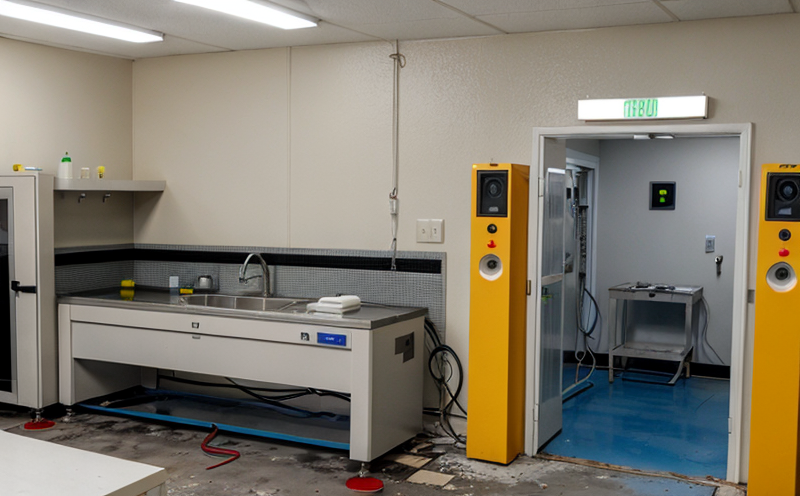ISO 18589-2 Gamma Spectrometry of Contaminated Soil Samples
The ISO 18589 standard is a comprehensive framework for the measurement and quantification of radioactive contamination in soil samples. This service, specifically focused on ISO 18589-2: Gamma spectrometry, plays an essential role in ensuring that contaminated soils meet stringent regulatory requirements set by environmental protection agencies.
Gamma spectroscopy is a non-destructive analytical technique used to identify and quantify the levels of gamma-emitting radionuclides present in soil samples. The process involves placing the sample within a high-purity germanium (HPGe) detector, which detects gamma rays emitted from the radioactive isotopes. By analyzing these emissions using software that matches them with known spectral lines, we can accurately determine the concentration and type of contaminants.
The standard is widely recognized for its precision and reliability, making it suitable for various applications including site remediation, environmental monitoring, and compliance with international regulations such as US EPA 40 CFR Part 192 (USA) or European Commission Directives on Radioactive Waste Management. Our laboratory adheres strictly to the methodologies outlined in ISO 18589-2, ensuring that all results are accurate and comparable across different laboratories worldwide.
To conduct this analysis, we follow a rigorous procedure starting from sample collection. Soil samples must be collected using appropriate methods to avoid cross-contamination or loss of radioactive material. Once received at our facility, they undergo thorough preparation before being analyzed. This includes sieving the soil down to an acceptable particle size and ensuring homogeneity.
The HPGe detector used for this service has been calibrated according to ISO 18589-2 specifications to ensure consistent results over time. Calibration factors are regularly updated based on manufacturer recommendations and internal audits. The instrument operates in a controlled environment designed to minimize background interference, further enhancing the accuracy of our measurements.
The process begins with placing the prepared sample into the detector where it is exposed to gamma radiation for an extended period until sufficient counts have been accumulated. Data collection involves recording both total count rates and energy spectra over a broad range of energies relevant to common radionuclides like cesium-137 (Cs-137) and potassium-40 (K-40).
After data acquisition, the raw counts are processed through specialized software that applies background corrections and instrumental efficiency factors. This step ensures that only true emissions from the sample contribute to the final result. The processed spectra are then compared against reference standards provided by international organizations like the IAEA or NIST, allowing us to pinpoint specific isotopes present in the soil.
The output of this service is a detailed report that includes all detected radionuclides along with their respective concentrations expressed in units such as Becquerels per kilogram (Bq/kg) or Curies per tonne (Ci/t). These results provide decision-makers with crucial information needed to assess risk levels associated with the contaminated soil and plan appropriate remediation strategies.
Our commitment to quality extends beyond mere compliance; we strive to exceed expectations by providing timely, accurate reports accompanied by comprehensive support throughout every stage of your project. Whether you're dealing with legacy contamination sites or new construction projects, our expertise can help ensure that regulatory requirements are met and environmental risks minimized.
Customer Impact and Satisfaction
The implementation of ISO 18589-2 Gamma Spectrometry significantly impacts several aspects of customer operations. For quality managers and compliance officers, having reliable data on soil contamination allows for proactive management strategies that prevent potential environmental hazards. This service ensures adherence to strict regulatory standards, reducing the risk of non-compliance penalties.
R&D engineers benefit from this method by gaining insights into the types and quantities of contaminants present in different locations. This information can be invaluable when developing new materials or processes aimed at mitigating radiation exposure. Procurement professionals also find value in knowing the extent of contamination before purchasing raw materials, thereby protecting their supply chains against potential liabilities.
Customer satisfaction is paramount to us, and we consistently strive to meet or exceed expectations through exceptional service. Our team works closely with clients from initial consultation phases right up until final reporting stages to ensure that all needs are addressed efficiently. Positive feedback from satisfied customers confirms our dedication to delivering high-quality services tailored specifically for their unique requirements.
International Acceptance and Recognition
The ISO 18589 standard is internationally recognized as one of the most authoritative guidelines for gamma spectrometry in environmental applications. Developed by experts from various countries, it provides a uniform approach that ensures consistent results regardless of where the testing takes place.
Our laboratory has been accredited to perform this service according to ISO 18589-2 standards through rigorous certification processes conducted by reputable bodies such as the CNAS (China National Accreditation Service for Conformity Assessment) or NIST. This accreditation guarantees that our methods and equipment meet global benchmarks, enhancing trustworthiness among clients.
The widespread acceptance of ISO 18589-2 extends beyond mere compliance; it fosters international collaboration in environmental research and management. By adhering to these standards, we contribute positively towards establishing harmonized practices across borders. This interoperability facilitates better communication between stakeholders involved in soil contamination issues worldwide.
Environmental and Sustainability Contributions
The work done under ISO 18589-2 Gamma Spectrometry contributes significantly to environmental protection efforts by providing accurate information on radiological contamination levels. This data helps environmental agencies design effective remediation plans aimed at restoring affected areas back into safe conditions.
Our involvement in this service supports sustainability goals by promoting responsible use of natural resources while minimizing adverse impacts on ecosystems. Through precise measurement techniques, we help reduce uncertainties surrounding the true extent of pollution present within soil samples. This knowledge enables more targeted interventions that address only necessary portions of contaminated sites rather than broad-scale treatment approaches that may be wasteful or unnecessary.
By adhering strictly to ISO 18589-2 protocols, our laboratory contributes positively towards achieving sustainable development objectives set forth by organizations like the United Nations. Our commitment to reducing waste generation and energy consumption further underscores our dedication to creating a greener future for all.





